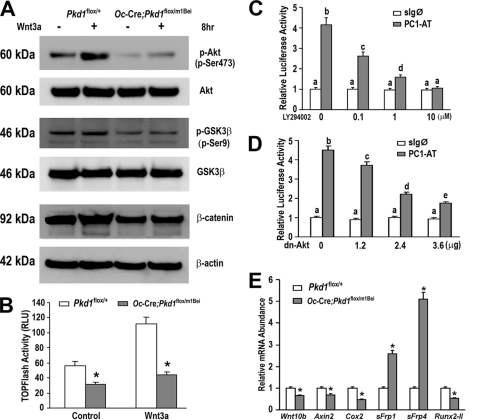FIGURE 5.
Signaling pathways in Pkd1Oc-cKO osteoblasts. A, Western blot analysis. Comparison of Akt, GSK3β, and β-catenin expressions in control and Pkd1Oc-cKO osteoblasts treated with or without Wnt3a (100 ng/ml) for the indicated times. Phosphorylated Akt at Ser-473 (panel 1) coincides with phosphorylation of GSK3β at Ser-9 (panel 3), reflecting its inactivation by Akt and followed by accumulation of cytoplasmic β-catenin, as detected by Western blot. Total Akt (panel 4), GSK3β (panel 4), and β-actin (panel 6) were used as loading controls for phospho-Akt, phospho-GSK3β, and β-catenin in the cytoplasm, respectively. Pkd1Oc-cKO osteoblasts exhibited suppressed activity of the PI3K-Akt-GSK3β-β-catenin signaling pathway under basal and Wnt3a-stimulated conditions. B, TCF/LEF-dependent transcriptional activation as assessed by pTOPFLASH activity. Pkd1Oc-cKO osteoblasts display lower levels of basal TCF/LEF-dependent reporter activity (TOPFLASH) when compared with control Pkd1flox/+ osteoblasts. Wnt3a (100 ng/ml) induced reporter activity by more than 2.0-fold above control in Pkd1flox/+ osteoblasts, whereas Wnt3a induced reporter activity by only 1.4-fold above control in Pkd1Oc-cKO osteoblasts. C and D, PC1-mediated regulation of Runx2-II-P1 prompter activity via the PI3K/Akt pathway. Wild-type MC3T3-E1 cells were transiently transfected either with control expression vector (sIg℘) or gain-of-function PC1 C-tail construct (PC1-AT) along with the Runx2-II-P1 luciferase reporter (p0.42Runx2-P1-Luc) construct in the presence or absence of PI3K inhibitor LY294002 or dn-Akt construct. PC1-mediated activation of Runx2-II-P1 promoter activity was dose-dependently diminished by either PI3K inhibitor LY294002 or dn-Akt construct. E, gene expression profiles by real-time RT-PCR. 10-day cultured Pkd1Oc-cKO osteoblasts in differentiation medium showed a significant attenuation in WNT/β-catenin signaling compared with control osteoblasts, as evidenced by a significant down-regulation of WNT/β-catenin-targeting genes, including Wnt10b, Axin2, Cox2, and Runx2-II, and up-regulation of its antagonist genes, such as sFrp1 and sFrp4. Data are mean ± S.D. from triple independent experiments. *, significant difference from control (Pkd1flox/+) mice at p < 0.05. Values sharing the same superscript in C and D are not significantly different at p < 0.05.

